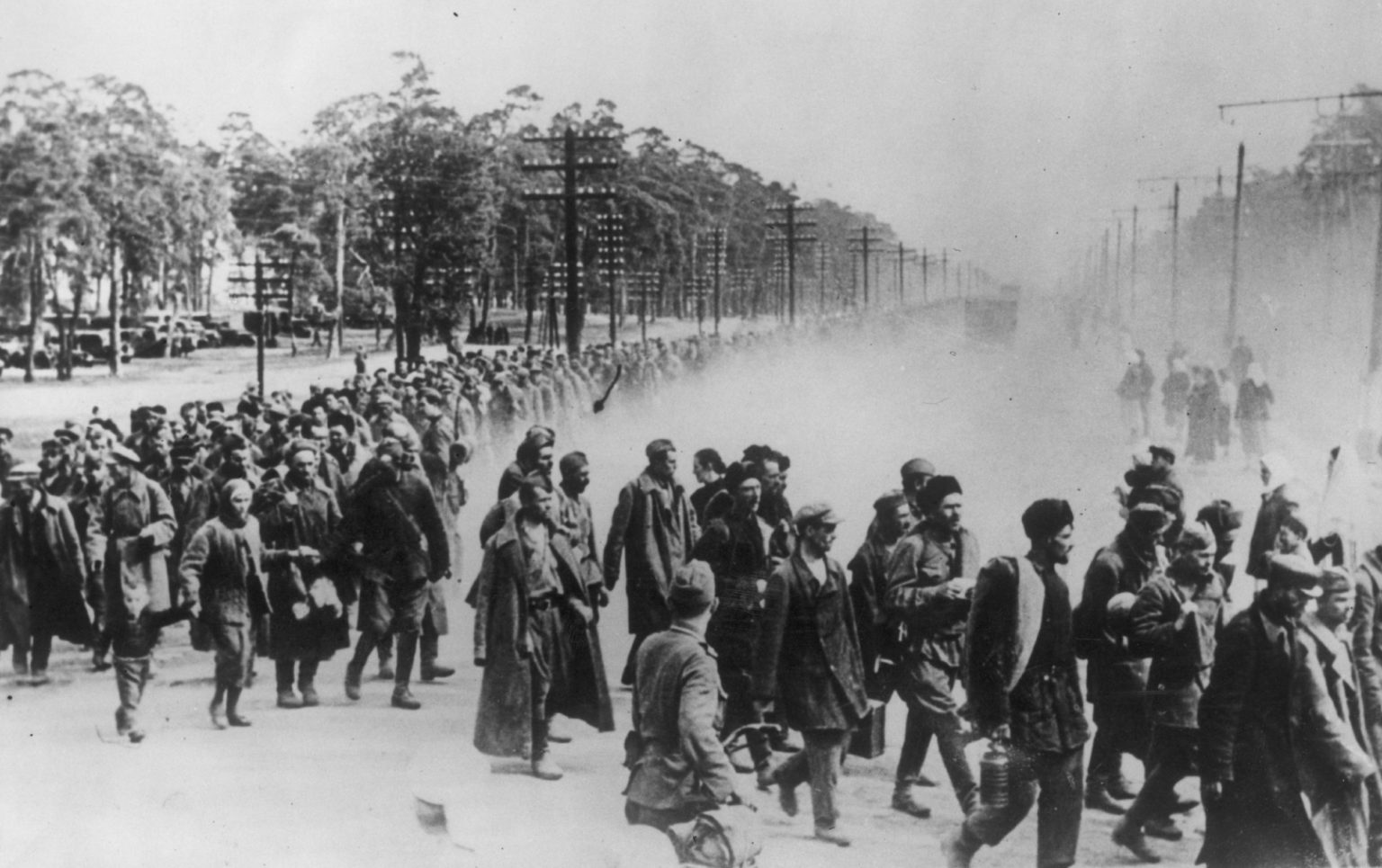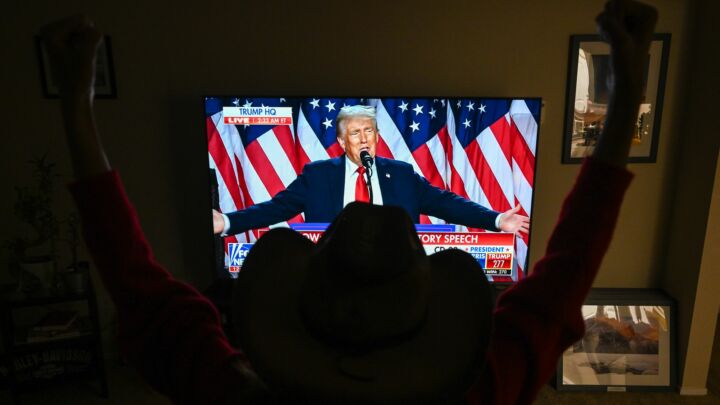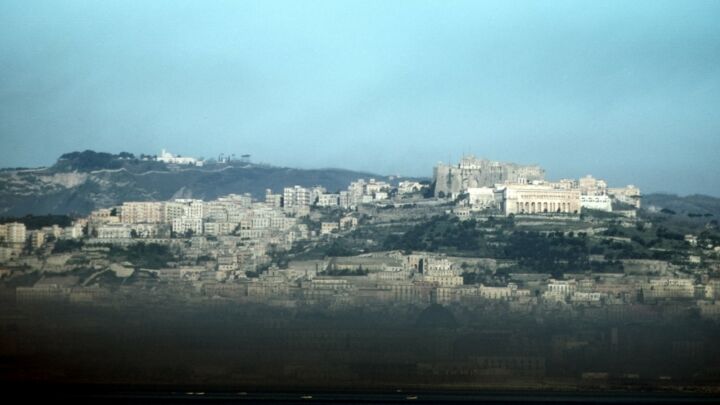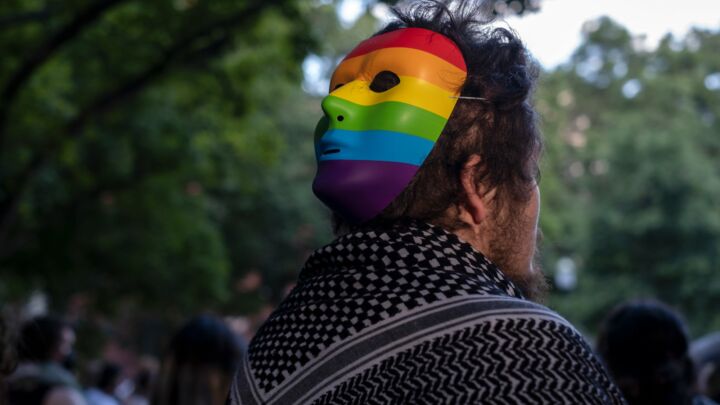
Long-read
Operation Barbarossa: the most barbarous conflict in history
The Nazi invasion of the Soviet Union continues to cast a shadow over east-west relations today.
Want to read spiked ad-free? Become a spiked supporter.
At 3am on 22 June 1941 – one year to the day after France fell to the Nazis – the largest invasion force in history entered the Soviet Union. Operation Barbarossa had begun.
Nazi forces attacked in three groups across an 1,800-mile front, and advanced towards Leningrad, Kiev and Moscow. Alongside their German core, the three million troops included Italian, Hungarian, Romanian, Finnish, Slovak and Croatian soldiers.
This attack was to be the beginning of the most costly and barbarous conflict in history. And its outcome, which determined the future of Europe for more than half a century, still casts its shadow over east-west relations to this day.
Though Russia possessed three times the number of aircraft and tanks that Germany did, the momentum of the German ground and air attack rapidly destroyed the organisation of Soviet defences. Much of the Soviet air force was destroyed on the ground, and thousands of soldiers found themselves surrounded and were forced to surrender.
It took several days for Soviet leader Joseph Stalin to come to terms with the catastrophe. He retreated to his dacha – his summer house on the Black Sea – and didn’t return to the Kremlin until 1 July, when he made his first speech since the invasion had begun.
By the following day, German forces were nearly 200 miles into Soviet territory and on the road to Moscow. In the north they had cut through Lithuania and Latvia to threaten Leningrad. By mid-July, German forces had advanced to within a few miles of Kiev, having captured 300,000 Soviet prisoners and destroyed 2,500 tanks and 250 aircraft.
The Red Army at the time was the largest army in the world. But it had been beheaded by Stalin’s terror, with over 80,000 Red Army officers executed between 1937 and June 1941 (1). This included more than half of the regiment commanders, which meant they had been replaced by inexperienced officers appointed largely on the basis of political expediency rather than merit or achievement.
Hitler’s primary objective had always been east. Ultimately, he sought to destroy and replace the British Empire, but he believed that he had to destroy the Soviet Union first, and then utilise its natural resources to return the war to Britain. Or as Hitler himself put it, ‘The road to London ran through Moscow’.
A war of annihilation
In the west there were Aryans. In the east there were Poles, Slavs and Jews – in short, the Untermensch. Hence Hitler impressed upon his generals that Barbarossa was not to be subject to the normal rules of war; rather, it was to be a war of annihilation. The Nazis’ Generalplan Ost (General Plan for the East), commissioned by Heinrich Himmler, was the Nazis’ strategy for ethnic cleansing, genocide and the subsequent colonisation of central and eastern Europe by Germans. The aim was to erase Slavic people through extermination, enslavement and deportation. The scale of deportation envisaged involved sending up to 31million people to Siberia.
In May 1941, seven weeks prior to the invasion, officials responsible for formulating Germany’s economic policy met in Berlin. Minutes of the meeting survived in two parts. Part one begins:
‘The war can only be waged if the entire Wehrmacht is fed during the third year of the war. As a result, millions of people will doubtlessly starve if that which is necessary for us is extracted from the land.’ (3)
The Nazis devised a specific ‘hunger plan’, whereby food resources would be taken from Soviet territory and transported to the German people. Because of military setbacks, the plan was never fully implemented. However, famine was still engineered, particularly in the Ukraine, with German soldiers instructed to stiffen their resolve and remember that food given to starving children was food denied to Germans back home.

Soviet prisoners of war, meanwhile, were starved as a matter of policy. The most reliable figures for the death rate among Soviet POWs in German captivity reveal that 3.3million died, mostly as a result of starvation, from a total of 5.7million captured between June 1941 and February 1945.
Following in the wake of the Blitzkrieg into the east went the Einsatzgruppen (deployment groups). These were mobile killing units run by the SS. They were responsible for the mass murder of civilians. Indeed, six months into the invasion, the Einsatzgruppen had murdered over half a million Soviet Jews, more than the number of Red Army soldiers killed in combat during that time.
But it was not just the SS who murdered indiscriminately. Many German troops viewed the war in Nazi terms, and regarded Soviet people as sub-human. In the words of the Generalplan Ost, it was ‘a question of existence. Thus it will be a racial struggle of pitiless severity, in the course of which 20 to 30million Slavs and Jews will perish through military actions and crises of food supply.’ (4)
Krasnodar, a city in southern Russia, was occupied by the 17th German army, commanded by Colonel General Ruoff, between 12 August 1942 and 12 February 1943. Forces included an Einsatzgruppen and a Sonderkommando unit of around 200 death-camp prisoners, who were forced to dispose of victims. Many people, including children and hospital patients, were put to death by shooting, hanging, burning and the use of ‘murder vans’ that piped carbon monoxide into a zinc-lined rear storage area. As one contemporary observer put it:
‘Not only prisoners, but people indiscriminately seized in the street during wholesale raids were put to death in the murder vans… A spectacle of particular horror was the massacre of Soviet children and adolescents. These were by no means isolated instances of Germans throwing little children into pits and burying them alive… In December 1941 the Gestapo shot 900 Soviet citizens who were undergoing treatment at Kharkiv hospital.’ (5)
This mode of methodical slaughter led directly to the Final Solution. Seven months after Barbarossa, on 20 January 1942, 15 senior German officials met at a villa on the shores of Berlin’s Lake Wannsee. The purpose of the two-hour meeting was to coordinate the genocide of Europe’s Jews. The meeting was called and chaired by the chief of the Reich Security main office, Reinhard Heydrich. In the Nazis’ mindset, the Wannsee meeting was a logical development of the Berlin meeting of May 1941, at which the Nazis planned out the mass starvation of eastern peoples.
The Red Army resists
Russia’s strategy was to trade space for time, and allow its army to regroup and rebuild far beyond enemy lines. And space there was. The unimaginable vastness of the Russian steppes was disorientating to the invaders.
Stalin, meanwhile, adopted a scorched-earth policy to deny the enemy supplies. Russian railroads had a different gauge and Russia destroyed the trains they could not withdraw, impeding the German advance. Munitions plants were shipped to the Urals and Siberia. As far as possible, the Red Army lived off the land in the manner of European armies centuries before.
In early October 1941, German forces reached the outskirts of Moscow. They captured 700,000 Russian prisoners, but the Muscovites didn’t give up. Civilians dug defences, carted supplies to the front and cared for injured soldiers in their homes.
Still, it was anticipated that the capital would fall by mid-October. Two million residents fled and even Lenin’s coffin was secreted away. Stalin publicly remained, attempting to instil calm.
Then, on 7 October, the first snow fell and thawed, and German artillery and tanks found themselves bogged down in the mud and unable to advance. Then the temperature suddenly dropped, reaching minus 40 degrees celsius – it was the harshest winter for many years. The Germans were ill-clad and ill-prepared. They were lacking in winter equipment and their engines were without antifreeze. Oil solidified and mobility screeched to a halt.
T34 Russian tanks, impervious to German tank shells, were mobile. By November, Germany had suffered 730,000 casualties. On 6 December 1941, General Georgy Zhukov, who had overseen Moscow’s defences, launched a successful counter-offensive. Hitler’s delusions of establishing a thousand-year Reich across Europe were put to the sword.

A saying arose in the Red Army, ‘Where Zhukov is, there is victory’. A shoemaker’s son, Zhukov had fought in the First World War as a Tsarist cavalryman. As well as the Battle of Moscow, he directed the defences at the Siege of Leningrad, where he deployed tanks behind forward positions to kill any fleeing Soviet soldiers.
In August of 1942 he was sent to command the defence of Stalingrad, and it was here, between August 1942 and February 1943, with a combined two million casualties, that the Red Army won the decisive victory. Friedrich Paulus’s German Sixth Army was surrounded and, after suicidal attempts to break out, it surrendered on 2 February 1943.
Many historians consider this to be the turning point of the Second World War. After it, the Nazis’ retreat began, and their forces were driven back at an ever-increasing rate. Russian people were not inferior after all.
Britain lauds the Reds
British assistance to the Soviet Union for the most part took the form of the supply of arms and equipment. By late 1941, a convoy of shipping left for Archangel, a city in north-western Russia, every 10 days. The convoy of 12 October included: 140 heavy tanks; 100 Hurricane fighter aircraft; 200 Bren carriers; 200 anti-tank rifles and ammunition; and 50 two-pounder guns and shells. On 22 October, Britain sent over a further 200 fighter aircraft and 120 heavy tanks. George Orwell remarked, ‘we are giving Russia all aid short of war’ (6).
The astonishing resistance of the Red Army and of the Russian people generated widespread sympathy for the Soviet Union in Britain. Churchill had set the tone with an emotional broadcast at the outset of Barbarossa, stating that ‘the cause of any Russian fighting for his hearth and home is the cause of free men and free peoples in every quarter of the globe’. Lady Churchill headed an Aid for Russia campaign from October 1941 onwards. To commemorate the 25th anniversary of the establishment of the Red Army, the British government celebrated Red Army Day on 21 February 1943. The Royal Albert Hall hosted a pageant involving 2,000 participants entitled ‘Salute to the Red Army’. William Walton composed, Sir Malcolm Sargent conducted, and Louis MacNeice provided the poetry.
There were also demonstrations, rallies and celebrations across the UK. On command of the king, a bejewelled ‘sword of Stalingrad’ was forged as a token to the defenders of the city. It was displayed at Westminster Abbey and people queued for hours to see it.
By the summer of 1943, Communist Party membership in Britain rose to around 60,000. Many of the recruits worked in armament factories where the Communists campaigned for increased production and a second military front to be opened in France. Metropolitan Vickers, an engineering company in Manchester which made equipment for the northern convoys to Archangel, received a visit from a Russian trade-union leader. Communist shop steward Benny Rothman recalled it many years later:
‘The support he got was enthusiastic beyond imagination. He was invited to come down to the director’s dining room, but he wanted to go to the workers’ canteen instead, and he was very warmly and genuinely cheered. No question about that.’
Russia remembers
In a conscious reference to the resistance to Bonaparte’s armies, known as the Patriotic War of 1812, Stalin named the war with Germany as the Great Patriotic War. It was this immense struggle that sealed the fate of Hitler’s forces. Eighty per cent of German military losses were suffered on the eastern front, and defeat became inevitable as early as the end of 1941.
What followed was three and a half years of rare savagery. Both sides ignored the Geneva Convention, and showed no quarter and no mercy. German officers routinely overlooked the torture of Russian soldiers and civilians. And Soviet soldiers committed mass rape not only of German women and children, but also of female Soviet forced labour.
The Second World War occupies a very different part of the national memory in Russia than it does in the West. The anniversary of Barbarossa is marked each year by a Day of Remembrance and Sorrow. National flags are lowered. Flags with mourning ribbons are hung from houses. And TV and radio entertainment is cancelled for the day. The bodies of victims, which are still being discovered each year by search parties, are buried with military honours.
It is thought that at least 27million Soviet people lost their lives, but the real figure will probably never be known. Unlike the British, Russians are not nostalgic about the Second World War. It is hard to imagine a version of Dad’s Army set among partisans in Minsk, or a sitcom like ‘Allo ‘Allo! in occupied Ukraine. The Red Army did not have a Vera Lynn. Instead, it had the soldier poet Konstantin Simonov, whose two best-loved poems were ‘Wait for Me’ (Russian soldiers did not get leave) and ‘Kill Him’, copies of which were dropped from planes to the defenders of Stalingrad.
Over the past few years, remembrance in Russia has become an increasingly politicised issue. President Vladimir Putin has used Russia’s victory to bolster nationalism and even to rehabilitate Stalin. On Victory Day, 9 May 2019, Putin unveiled a bust of Stalin in the Siberian city of Novosibirsk, a place where political enemies were exiled to in the 1930s. In September of the same year, the European Union passed a provocative resolution that directly accused the Soviet Union of beginning the war alongside Nazi Germany, triggering Putin to write a lengthy essay on Western revisionism.
Russians’ perspective on the war is different. Many in the West should try looking at it through Russian eyes, with a Russian memory. From Russians’ vantage point, fascism was an evil that emerged from the West and had to be destroyed by them at enormous cost.
But it is also the case that the territory gained during the war then suffered under Soviet dictatorship, gulags included, for another 40 years. While Allied armies to the west may not have, as Churchill put it, ‘torn the guts out of the German military machine’, they did lay down their lives for the creation of new democracies. A greater acknowledgement of Russia’s suffering and achievements during the war, and remembrance of a once held common cause, could even now help form the basis of an east-west rapprochement.
Michael Crowley is an author and dramatist. Visit his website here.
Image published under a creative-commons licence.
(1) Revolutionary Russia, 1891-1991, by Orlando Figes, (Penguin, 2014), p306
(2) Codeword Barbarossa, by Barton Whaley, (MIT Press 1973), p15
(3) ‘Germany’s Staatssekretäre, Mass Starvation and the Meeting of 2 May 1941′, by Alex J Kay, in Journal of Contemporary History, Vol 41, No4, 2006, pp.685–700
(4) See The Origins of the Final Solution: The Evolution of Nazi Jewish Policy, September 1939-March 1942, by Christopher R Browning, (University of Nebraska Press, 2007)
(5) The People’s Verdict: Krasnodar and Kharkiv Nazi Atrocity Trials, by Ignatik Fedorovich Kladov, (Hutchinson & Co, 1944), p53
(6) ‘London Letter’, by George Orwell, in Partisan Review, 1941
(7) Interview with Benny Rothman, from the author’s personal collection
Celebrate 25 years of spiked!
A media ecosystem dominated by a handful of billionaire owners, bad actors spreading disinformation online and the rich and powerful trying to stop us publishing stories. But we have you on our side. help to fund our journalism and those who choose All-access digital enjoy exclusive extras:
- Unlimited articles in our app and ad-free reading on all devices
- Exclusive newsletter and far fewer asks for support
- Full access to the Guardian Feast app
If you can, please support us on a monthly basis and make a big impact in support of open, independent journalism. Thank you.






Comments
Want to join the conversation?
Only spiked supporters and patrons, who donate regularly to us, can comment on our articles.